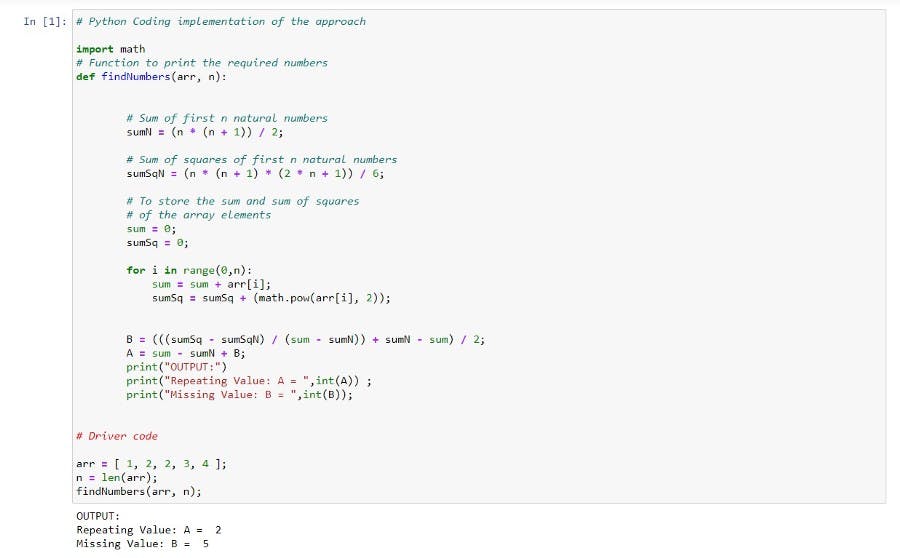Find the repeating and the missing value with time complexity O(n)[With Python Code].
Problem Statement: Given an array arr[ ] of size N, each integer from the range [1, N] appears exactly once except A which appears twice and B which is missing. The task is to find the numbers A and B.
Examples:
Input: arr[ ] = {2, 1, 2}
Output: Missing = 3, Repeating = 2
Explanation: In the array,
3 is missing and 2 occurs twice.
Input: arr[ ] = {2, 1, 2, 3, 4}
Output:
A = 2 (Repeating)
B = 5 (Missing)
Input: arr[ ] = {5, 3, 4, 5, 1}
Output:
A = 5 (Repeating)
B = 2 (Missing)
Approach: Our approaches should be having Time Complexity O(n).
So, let's do it with natural numbers concepts.
I am assigning an array. Let's say, arr = [ 1, 2, 2, 3, 4 ]
We have to find A(Repeating Value) and B (Missing Value).
Step 1: From the sum of first N natural numbers,
SumN = 1 + 2 + 3 + … + N = (N (N + 1)) / 2
So, SumN= (1+2+3+4+5)= (5(5+1))/2 =15. [Here N=5]
We took 1st 5 natural numbers because in our Array there are 5 numbers.
And, let the sum of all the array elements be Sum.
Sum= (1+2+2+3+4)=12.
Now,
SumN = Sum - A + B
A -B = Sum - SumN
So, A-B = 12 -15 → A-B= -3 → Equation 1.
And from the sum of the squares of first N natural numbers,
SumSqN = 1² + 2² + 3² + … + N²= (N (N + 1) (2n + 1)) / 6 .[Here N=5]
So, SumSqN= 1²+ 2²+3²+4²+5² = 55.
And, let the sum of the squares of all the array elements be SumSq.
SumSq= 1²+2²+2²+3²+4²=34.
Now,
SumSq = SumSqN + A² - B²
SumSq - SumSqN = (A + B) (A - B)
So, 34–55= (A + B) (A - B) → -21=(A + B) (A - B) → Equation 2.
Put value of (A - B) from equation 1 in equation 2,
-21=(A + B) (A - B) → -21=(A+B)(-3)
A + B = -21 / (-3) = 7 →(Equation 3)
Solving equation 1 and equation 3 will give,
B = (((SumSq - SumSqN) / (Sum - SumN)) + SumN - Sum) / 2
And, A = Sum - SumN + B.
B= (((34–55)/(12–15))+15–12)/2 =5 [Missing value]
A= 12–15+5= 2 [Repeating Value]
Now, we will execute this through python coding.

This above approach will take no extra space only having time complexity (Linear)in O(n).

![Find the repeating and the missing value with time complexity O(n)[With Python Code].](https://cdn.hashnode.com/res/hashnode/image/upload/v1623435845090/NahjeXgzu1.jpeg?w=1600&h=840&fit=crop&crop=entropy&auto=compress,format&format=webp)